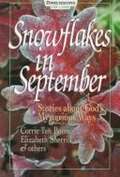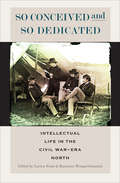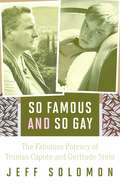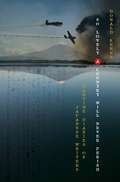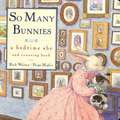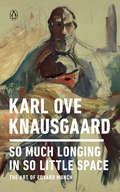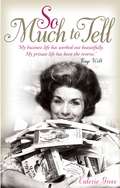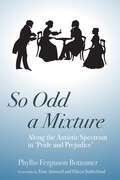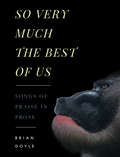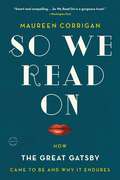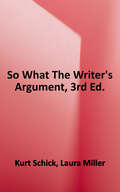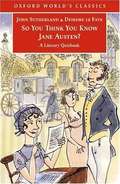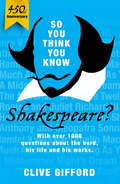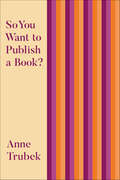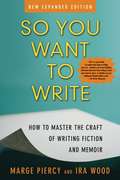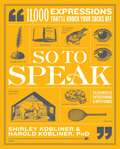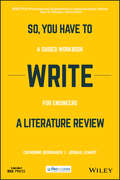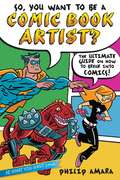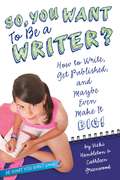- Table View
- List View
Snowflakes in September: Stories about God's Mysterious Ways
by Corrie Ten Boom Ernest Borgnine Caterine MarsallCorrie Ten Boom, Ernest Borgnine, and Elizabeth Sherrill are among the contributors to this unique collection. As they stir in the reader a sense of awe for the divine ways of God, the stories offer dramatic proof that God is an active part in the everyday lives of ordinary people.
So Conceived and So Dedicated: Intellectual Life in the Civil War-Era North (The\north's Civil War Ser.)
by Lorien Foote and Kanisorn Wongsrichanalai&“Outstanding essays&” exploring how educated Northerners viewed, and discussed, the Civil War (Michael B. Ballard, Civil War News). With contributions from multiple historians, this volume addresses the role intellectuals played in framing the Civil War and implementing their vision of a victorious Union. Broadly defining &“intellectuals&” to encompass doctors, lawyers, sketch artists, college professors, health reformers, and religious leaders, the essays address how these thinkers disseminated their ideas, sometimes using commercial or popular venues and organizations to implement what they believed. To what extent did educated Americans believe that the Civil War exposed the failure of old ideas? Did the Civil War promote new strains of authoritarianism in northern intellectual life, or reinforce democratic individualism? How did it affect northerners&’ conception of nationalism and their understanding of their relationship to the state? These essays explore myriad topics, including: *How antebellum ideas about the environment and the body influenced conceptions of democratic health *How leaders of the Irish American community reconciled their support of the United States and the Republican Party with their allegiances to Ireland and their fellow Irish immigrants *How intellectual leaders of the northern African American community explained secession, civil war, and emancipation *The influence of southern ideals on northern intellectuals *Wartime and postwar views from college and university campuses—and the ideological acrobatics that professors at Midwestern universities had to perform in order to keep their students from leaving the classroom *How northern sketch artists helped influence the changing perceptions of African American soldiers over the course of the war Collectively, So Conceived and So Dedicated offers an in-depth look at this part of the nation&’s intellectual history—and suggests that antebellum modes of thinking remained vital and tenacious well after the Civil War.
So Famous and So Gay: The Fabulous Potency of Truman Capote and Gertrude Stein
by Jeff SolomonGertrude Stein (1874–1946) and Truman Capote (1924–1984) should not have been famous. They made their names between the Oscar Wilde trial and Stonewall, when homosexuality meant criminality and perversion. And yet both Stein and Capote, openly and exclusively gay, built their outsize reputations on works that directly featured homosexuality and a queer aesthetic. How did these writers become mass-market celebrities while other gay public figures were closeted or censored? And what did their fame mean for queer writers and readers, and for the culture in general? Jeff Solomon explores these questions in So Famous and So Gay.Celebrating lesbian partnership, The Autobiography of Alice B. Toklas was published in 1933 and rocketed Stein, the Jewish lesbian intellectual avant-garde American expatriate, to international stardom and a mass-market readership. Fifteen years later, when Capote published Other Voices, Other Rooms, a novel of explicit homosexual sex and love, his fame itself became famous. Through original archival research, Solomon traces the construction and impact of the writers&’ public personae from a gay-affirmative perspective. He historically situates author photos, celebrity gossip, and other ephemera to explain how Stein and Capote expressed homosexuality and negotiated homophobia through the fleeting depiction of what could not be directly written—maneuvers that other gay writers such as Gore Vidal, Tennessee Williams, and James Baldwin could not manage at the time. Finally So Famous and So Gay reveals what Capote&’s and Stein&’s debuts, Other Voices, Other Rooms and Three Lives, held for queer readers in terms of gay identity and psychology—and for gay authors who wrote in their wake.
So Long as Men Can Breathe
by Clinton HeylinIn this lively, fascinating account of the publication of Shakespeare’sSonnets, noted biographer Clinton Heylin brings their convoluted history to light, beginning with the first complete appearance of theSonnetsin print in May, 1609. He introduces us to the "unholy alliance” involved in this precarious enterprise: Thomas Thorpe, the publisher, a self-described "well wishing adventurer;” George Eld, the printer, heavily embroiled in large-scale pirating; William Aspley, the prestigious bookseller, who mysteriously ended his association with Thorpe soon after. Leaving the calamitous world of Elizabethan publishing, Heylin goes on to chart the many editions of theSonnetsthrough the years and the editorial decisions that led to their present configuration. Passionate, astute, and brilliantly entertaining, the result is a concise and vivid history of perhaps the greatest poetry ever written.
So Long as Men Can Breathe
by Clinton HeylinIn this lively, fascinating account of the publication of Shakespeare's Sonnets, noted biographer Clinton Heylin brings their convoluted history to light, beginning with the first complete appearance of the Sonnets in print in May, 1609. He introduces us to the "unholy alliance" involved in this precarious enterprise: Thomas Thorpe, the publisher, a self-described "well wishing adventurer;" George Eld, the printer, heavily embroiled in large-scale pirating; William Aspley, the prestigious bookseller, who mysteriously ended his association with Thorpe soon after.Leaving the calamitous world of Elizabethan publishing, Heylin goes on to chart the many editions of the Sonnets through the years and the editorial decisions that led to their present configuration. Passionate, astute, and brilliantly entertaining, the result is a concise and vivid history of perhaps the greatest poetry ever written.
So Lovely a Country Will Never Perish
by Donald KeeneThe attack on Pearl Harbor, which precipitated the Greater East Asia War and its initial triumphs, aroused pride and a host of other emotions among the Japanese people. Yet the single year in which Japanese forces occupied territory from Alaska to Indonesia was followed by three years of terrible defeat. Nevertheless, until the shattering end of the war, many Japanese continued to believe in the invincibility of their country. But in the diaries of well-known writers-including Nagai Kafu, Takami Jun, Yamada Futaru, and Hirabayashi Taiko-and the scholar Watanabe Kazuo, varying doubts were vividly, though privately, expressed. Donald Keene, renowned scholar of Japan, selects from these diaries, some written by authors he knew well. Their revelations were sometimes poignant, sometimes shocking to Keene. Ito Sei's fervent patriotism and even claims of racial superiority stand in stark contrast to the soft-spoken, kindly man Keene knew. Weaving archival materials with personal recollections and the intimate accounts themselves, Keene reproduces the passions aroused during the war and the sharply contrasting reactions in the year following Japan's surrender. Whether detailed or fragmentary, these entries communicate the reality of false victory and all-too-real defeat.
So Lovely a Country Will Never Perish: Wartime Diaries of Japanese Writers (Asia Perspectives: History, Society, and Culture)
by Donald KeeneThe attack on Pearl Harbor, which precipitated the Greater East Asia War and its initial triumphs, aroused pride and a host of other emotions among the Japanese people. Yet the single year in which Japanese forces occupied territory from Alaska to Indonesia was followed by three years of terrible defeat. Nevertheless, until the shattering end of the war, many Japanese continued to believe in the invincibility of their country. But in the diaries of well-known writers-including Nagai Kafu, Takami Jun, Yamada Futaru, and Hirabayashi Taiko-and the scholar Watanabe Kazuo, varying doubts were vividly, though privately, expressed.Donald Keene, renowned scholar of Japan, selects from these diaries, some written by authors he knew well. Their revelations were sometimes poignant, sometimes shocking to Keene. Ito Sei's fervent patriotism and even claims of racial superiority stand in stark contrast to the soft-spoken, kindly man Keene knew. Weaving archival materials with personal recollections and the intimate accounts themselves, Keene reproduces the passions aroused during the war and the sharply contrasting reactions in the year following Japan's surrender. Whether detailed or fragmentary, these entries communicate the reality of false victory and all-too-real defeat.
So Many Bunnies
by Rick WaltonFrom the Publisher: Follow Mother Rabbit through her rambling house and garden as she tucks in a whole alphabet of baby bunnies, from Abel through Zed. This cozy bedtime book has the comforting familiarity of a lullaby combined with the fundamental concepts toddlers adore. From Children's Literature - Mary Quattlebaum: So Many Bunnies does double-duty. It gets kids hip-hopping into Easter as well as into National Poetry Month, celebrated each April. Rick Dalton's ingenious rhyming text weaves alphabet and counting lessons into a sweet tale of Old Mother Rabbit who lived in a shoe. Unlike her human counterpart, Mother Rabbit knows just what to do and where to tuck her twenty-six sleepy darlings, from "1 was named Abel./He slept on the table" to "26 was named Zed./He slept on the shed." Paige Miglio's soft-toned watercolors are a lovely complement to this lullaby.
So Much Longing in So Little Space: The Art of Edvard Munch
by Karl Ove KnausgaardA brilliant and personal examination by sensational and bestselling author Karl Ove Knausgaard of his Norwegian compatriot Edvard Munch, the famed artist best known for his iconic painting The ScreamIn So Much Longing in So Little Space, Karl Ove Knausgaard sets out to understand the enduring and awesome power of Edvard Munch’s work by training his gaze on the landscapes that inspired Munch and speaking firsthand with other contemporary artists, including Anselm Kiefer, for whom Munch’s legacy looms large. Bringing together art history, biography, and memoir, Knausgaard tells a passionate, freewheeling, and pensive story about not just one of history’s most significant painters, but the very meaning of choosing the artist’s life, as he himself has done. Including reproductions of some of Munch’s most emotionally and psychologically intense works, chosen by Knausgaard, this utterly original and ardent work of criticism will delight and educate both experts and novices of literature and the visual arts alike.
So Much To Tell
by Valerie GroveKaye Webb, a journalist with no publishing experience, burst into the world of children's books in 1961 and changed the face of children's publishing forever. Her child-like enthusiasm and shrewd business mind led her to become Puffin's most successful editor and the genius behind the Puffin Club, which opened up the exciting world of authors and books to children across Britain. But whilst Kaye's professional life had worked out beautifully, her private life had been the reverse. Kaye had two husbands before her marriage to the artist Ronald Searle, and the torment of his sudden and shocking departure never left her.Yet to the outside world Kaye Webb remained passionate and unstoppable. This is the unknown story of the woman who brought the joy of books to children everywhere whilst battling the emotional pain that plagued her private life.
So Odd a Mixture: Along the Autistic Spectrum in 'Pride and Prejudice'
by Anthony Attwood Phyllis Ferguson-BottomerAutism was not a recognised disorder in Jane Austen's lifetime, nor for well over a century after her death. However there were certainly people who had autism, and Phyllis Ferguson Bottomer proposes that Austen wrote about them, without knowing what it was that she was describing. So Odd a Mixture looks at eight seemingly diverse characters in Austen's classic novel, Pride and Prejudice, who display autistic traits. These characters - five in the Bennet family and three in the extended family of the Fitzwilliams - have fundamental difficulties with communication, empathy and theory of mind. Perhaps it is high-functioning autism or Asperger's Syndrome that provides an explanation for some characters' awkward behaviour at crowded balls, their frequent silences or their tendency to lapse into monologues rather than truly converse with others. This fascinating book will provide food for thought for students and fans of Austen's classic novel, and for anyone interested in autism spectrum disorders.
So Very Much the Best of Us: Songs of Praise in Prose
by Brian DoyleIs Brian Doyle the most passionate Catholic storyteller in America? Here is new evidence that he is. In this brand new compilation of some of his best stories that have appeared in various publications throughout the world, Doyle explores the promise of Catholicism in America that he has experienced and observed from his childhood through today.
So We Read On: How The Great Gatsby Came to Be and Why It Endures
by Maureen CorriganThe "Fresh Air" book critic investigates the enduring power of The Great Gatsby -- "The Great American Novel we all think we've read, but really haven't."Conceived nearly a century ago by a man who died believing himself a failure, it's now a revered classic and a rite of passage in the reading lives of millions. But how well do we really know The Great Gatsby? As Maureen Corrigan, Gatsby lover extraordinaire, points out, while Fitzgerald's masterpiece may be one of the most popular novels in America, many of us first read it when we were too young to fully comprehend its power. Offering a fresh perspective on what makes Gatsby great-and utterly unusual-So We Read On takes us into archives, high school classrooms, and even out onto the Long Island Sound to explore the novel's hidden depths, a journey whose revelations include Gatsby's surprising debt to hard-boiled crime fiction, its rocky path to recognition as a "classic," and its profound commentaries on the national themes of race, class, and gender. With rigor, wit, and infectious enthusiasm, Corrigan inspires us to re-experience the greatness of Gatsby and cuts to the heart of why we are, as a culture, "borne back ceaselessly" into its thrall. Along the way, she spins a new and fascinating story of her own.
So What?: The Writer's Argument
by Laura Miller Kurt SchickThis book teaches students how to write compelling arguments and explains why practicing argumentation is essential to learning and communicating with others. Practical exercises throughout each chapter reinforce this broader academic aim by focusing on the key issue of significance-helping writers answer the "So What?" question for themselves and their audiences. By showing students how their writing fits within the broader context of academic inquiry, the book encourages them to emulate and adapt authentic academic styles, foundational organizing structures, and helpful rhetorical moves to their college classes and beyond.
So You Think You Know Jane Austen? A Literary Quizbook
by John Sutherland Deidre Le FayeHow well do you really know your favorite author? In this new book, ace literary detective turned quiz master John Sutherland and Austen buff Deirdre Le Faye challenge you to find out. Starting with easy, factual questions that test how well you remember a novel and its characters, the quiz progresses to a level of greater difficulty, demanding close reading and interpretative deduction. What really motivates the characters, and what is going on beneath the surface of the story? Designed to amuse and divert, the questions and answers take the reader on an imaginative journey into the world of Jane Austen, where hypothesis and speculation produce fascinating and unexpected insights. The questions are ingenious and fun, and the answers (located in the back of the book), in Sutherland's inimitable style, are fascinating. Completing the book guarantees a hugely improved knowledge and appreciation of Austen. Whether you are an expert or enthusiast, So You Think You Know Jane Austen? guarantees you will know her much better after reading it.
So You Think You Know: Shakespeare
by Clive GiffordIn which play would you find the characters, Bottom, Quince, Puck and Titania? How many of Shakespeare's history plays featured a King called Henry in their title? Does Juliet die by poison, stabbing herself or throwing herself off of a balcony? So you've read Shakespeare's plays, maybe seen them performed. Now you can test whether you really know about his plays and his extraordinary life. There are quizzes on Shakespeare's life and times including questions on plays and theatres of the time; the 15 most popular plays each has a dedicated quiz; there are 5 additional quizzes covering Shakespeare's remaining works - Poems & Sonnets/ Histories/ Tragedies/ Comedies/ Romances.
So You Want To Be An Interpreter?: An Introduction to Sign Language Interpreting (Fourth Edition)
by Janice H. Humphrey Bob J. AlcornBob Alcorn and I began the first edition of this book in 1984 with a single goal in mind of conveying sign language interpretation as the captivating, challenging, exciting and critically important discipline that it is.
So You Want to Publish a Book?
by Anne TrubekThe founder of Belt Publishing demystifies the publishing process, offering some insider how-to advice for aspiring authors. This slim but insightful guide offers concrete, witty advice and information to authors, prospective authors, and those curious about the publishing industry&’s inner workings. The chapters are chock full of important advice and information, including: · How advances and royalties really work · The surprising methods that actually move books off the shelves · The art of pitching to agents · The differences between Big Five and independent presses · The ins and outs of distribution, direct sales, and selling through Amazon Written by an industry veteran who&’s been on both the writing and publishing side, So You Want to Publish a Book? is a refreshing, no-nonsense, and transparent guide to how books get made and sold. For readers and writers looking for a straightforward guide for publishing, promoting, and selling their work. &“A compact, practical manual . . . a wealth of information usually only available to insiders.&” —The Times Literary Supplement
So You Want to Write
by Marge Piercy Ira WoodThe new expanded edition of the bestseller Booklist calls, "A must-have for would-be writers!" The one book a fiction or memoir writer needs, focusing on beginnings, character, dialogue, research, work habits, plot, memory, dealing with deeply personal material, and publishing.
So to Speak: 11,000 Expressions That'll Knock Your Socks Off
by Shirley Kobliner Harold KoblinerEngage with everyday expressions in a completely different (and fun!) way, with this entertaining and interactive book of common phrases that can turn a humdrum gathering into a raucous game night.We use expressions all the time. When you feel sick, you&’re &“under the weather.&” When you feel great, you&’re &“on top of the world.&” You may be fine with &“half a loaf,&” or you may insist on &“the whole enchilada.&” But whether you&’re a &“smart cookie&” or a tough one, you—and almost everyone you know—have a veritable smorgasbord of expressions stored deep in your brain. So to Speak: 11,000 Expressions That&’ll Knock Your Socks Off is the largest collection of its kind. Thoughtfully divided into sixty-seven categories—from Animals to Food & Cooking, from Love to Politics, this is not your run-of-the-mill reference guide. Don&’t look for definitions and etymologies, because the book is just the beginning. So to Speak is the launchpad for your lifelong journey to explore the universe of expressions. In fact, it&’s designed to get readers off the page—and engaging with each other. So to Speak spurs discussion, debate, and gameplay, while encouraging the art of listening and celebrating the joy of words. Authors Shirley and Harold Kobliner spent more than half a century nurturing and teaching children. So to Speak is a reflection of their deeply held belief that regardless of a person&’s age, the most impactful learning happens when you&’re having fun. Whether it&’s grandparents teaching their favorite expressions to their grandkids, teens helping adults with the latest lingo, or millennials indulging in their love of wordplay and games, this is the perfect book for any lover of language.
So you want to be a journalist? Unplugged
by Bruce Grundy Martin Hirst Janine Little Mark Hayes Greg TreadwellSo you want to be a Journalist? Unplugged is a fully revised guide to the world of journalism. This new edition of Bruce Grundy's guide for journalists takes us through new media's impact on the structure and practice of journalism today, with its 24-hour news cycle of multi-platform, interactive media audiences. The book contains instructions on writing for news media as well as practical advice on all facets of reporting. Skills involved in finding information, interviewing, writing news and features, research and investigation, basic subbing, layout and design are covered, along with the essentials of grammar, the law, and practical tips on ethical and professional behaviour. New to the second edition: - online journalism incorporated throughout the text - vignettes and case studies that bring the text to life - examples from Australian, New Zealand and international media - extended section on ethics - extensively updated research section, to help students recognise quality internet research - extensive companion website including further writing practice
So, You Have to Write a Literature Review: A Guided Workbook for Engineers (IEEE PCS Professional Engineering Communication Series)
by Catherine Berdanier Joshua LenartIs a literature review looming in your future? Are you procrastinating on writing a literature review at this very moment? If so, this is the book for you. Writing often causes trepidation and procrastination for engineering students—issues that compound while writing a literature review, a type of academic writing most engineers are never formally taught. Consider this workbook as a "couch-to-5k" program for engineering writers rather than runners: if you complete the activities in this book from beginning to end, you will have a literature review draft ready for revision and content editing by your research advisor. So, You Have to Write a Literature Review presents a dynamic and practical method in which engineering students—typically late-career undergraduates or graduate students—can learn to write literature reviews, and translate genre-based writing instruction into easy-to-follow, bite-sized activities and content. Written in a refreshingly conversational style while acknowledging that writing is quite difficult, Catherine Berdanier and Joshua Lenart leverage their unique disciplinary backgrounds with decades of experience teaching academic engineering writing in this user-friendly workbook.
So, You Want to Be a Comic Book Artist?: The Ultimate Guide on How to Break Into Comics! (Be What You Want)
by Philip AmaraFind success as a comic book artist with this step-by-step guide to creating, publishing, and marketing your very own comics.The secrets to comic book creation are at your fingertips! This comprehensive guide details the steps to becoming a hit comic book maker—from creating compelling characters and illustrations to getting published and marketing a finished product—and is full of insights from world-famous artists from such companies as DC, Marvel, and Dark Horse. In addition to highlighting tips from seasoned pros, inspiring success stories from young artists are sprinkled throughout along with a resource list of potential publishers to help you hit the ground running. So, You Want to Be a Comic Book Artist? also features in-depth chapters on adapting a storyline for video games and movies, using social media to promote a finished product, and self-publishing your own comic. Whether you’re just starting out or have been drawing comics for years, this book will get you where you want to go.
So, You Want to Be a Writer?
by Cathleen Greenwood Vicki HambletonMake those writing dreams a reality with this comprehensive guide that explains how to go from staring at an empty page to becoming a published author.Designed to inspire creative expression and help aspiring young writers achieve their dreams, So, You Want to Be a Writer? takes readers through the fulfilling step-by-step process of becoming a professional writer, from learning how to generate ideas to getting published and promoting their work. Aspiring writers will learn how to tackle writer's block, improve technique, approach publishers, and more. A detailed list of magazines, websites, contests, and book publishers looking for young authors will keep readers' eyes on the prize, while exclusive interviews with bestselling authors and young published writers will keep them engaged and inspired. So, You Want to Be a Writer? includes exclusive insights from well-known authors, such as the late Jurassic Park author Michael Crichton and fantasy author Amanda Hocking, who self-published her first novels to huge buzz. And profiles on young writers who are out there working right now--from a Vanity Fair blogger to a lyricist--give a real-time perspective to the dream profession.
So, You Want to Be a Writer?: How to Write, Get Published, and Maybe Even Make It Big!
by Cathleen Greenwood Vicki HambletonMake those writing dreams a reality with this comprehensive guide that explains how to go from staring at an empty page to becoming a published author.Designed to inspire creative expression and help aspiring young writers achieve their dreams, So, You Want to Be a Writer? takes readers through the fulfilling step-by-step process of becoming a professional writer, from learning how to generate ideas to getting published and promoting their work. Aspiring writers will learn how to tackle writer's block, improve technique, approach publishers, and more. A detailed list of magazines, websites, contests, and book publishers looking for young authors will keep readers' eyes on the prize, while exclusive interviews with bestselling authors and young published writers will keep them engaged and inspired. So, You Want to Be a Writer? includes exclusive insights from well-known authors, such as the late Jurassic Park author Michael Crichton and fantasy author Amanda Hocking, who self-published her first novels to huge buzz. And profiles on young writers who are out there working right now--from a Vanity Fair blogger to a lyricist--give a real-time perspective to the dream profession.
